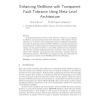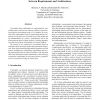638 search results - page 50 / 128 » Taming architectural evolution |
FPGA
1997
ACM
13 years 12 months ago
1997
ACM
Event identification in photon counting ICCD detectors requires a high level image analysis which cannot be easily described algorithmically: neural networks are promising to appr...
GI
2009
Springer
13 years 11 months ago
2009
Springer
: Today software systems have to face frequent requests for change during their whole lifetime. It is very important that they can adapt to the frequently changing needs and are fl...
SOSP
1993
ACM
13 years 9 months ago
1993
ACM
Research can rarely be performed on large-scale, distributed systems at the level of thousands of workstations. In this paper, we describe the motivating constraints, design princ...
JOT
2010
13 years 6 months ago
2010
In component-based systems, fault-tolerance concerns are typically handled by manually programmed fault containers. The purpose of fault containers is to prevent error propagation...
ICSE
2003
IEEE-ACM
14 years 7 months ago
2003
IEEE-ACM
Traceability helps stakeholders to understand the relationships that exist between software artifacts created during a software development project. For example, the evolution of ...


